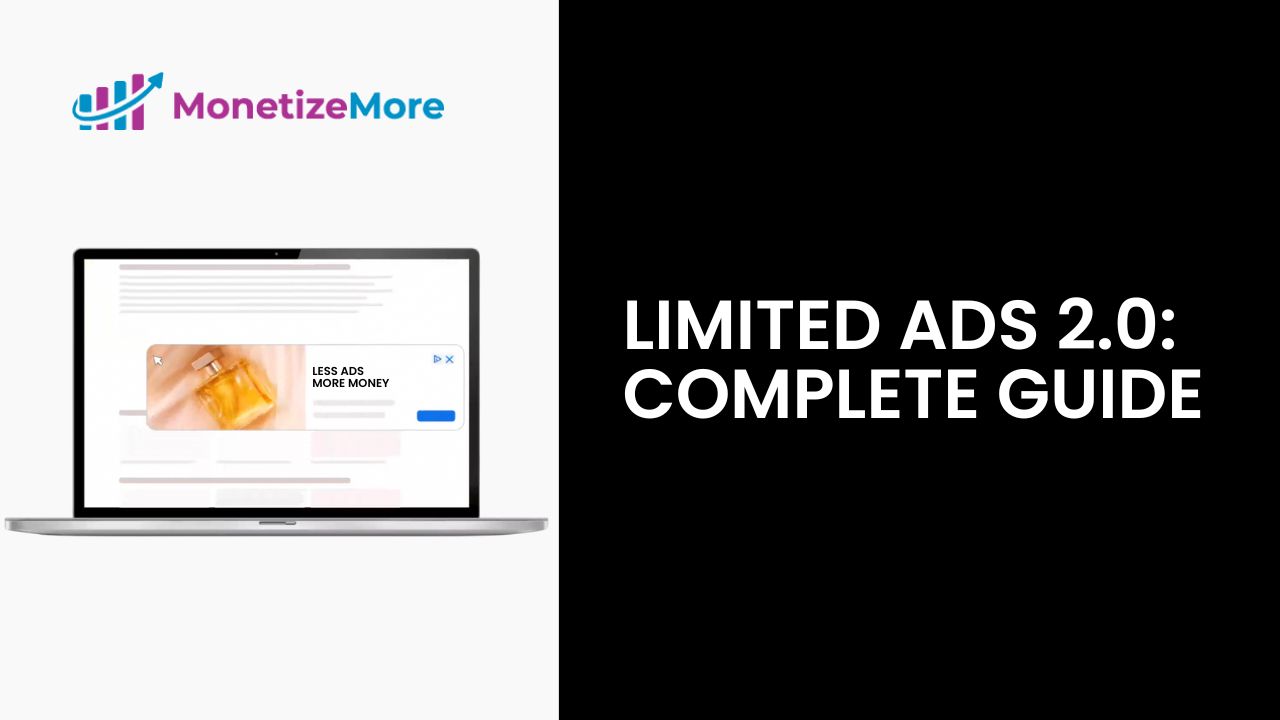
Limited Ads 2.0 is Google’s updated ad serving mode, launched in H1 2025 to help publishers comply with evolving privacy regulations, particularly GDPR. This new system replaces both the previous Limited Ads and Technical Ad Delivery options, streamlining Google’s ad serving offerings while providing more feature-rich options for publishers operating in low-data environments.
TL;DR: Limited Ads 2.0 allows publishers to monetize traffic when users haven’t provided full consent for personalized advertising, helping you maintain revenue while respecting privacy regulations.
With privacy regulations tightening globally and user consent becoming increasingly difficult to obtain, publishers face significant challenges in monetization. Recent industry data shows:
| Statistic | Value |
|---|---|
| Average opt-in rate for personalized ads in EU | 38-42% |
| Revenue loss without Limited Ads solution | 35-55% |
| Percentage of EU traffic requiring consent management | 100% |
| Estimated global privacy regulation adoption by 2026 | 75% of internet users |
Limited Ads 2.0 provides a crucial solution for recovering revenue from traffic that would otherwise be unmonetizable.
| Feature | Available? | Notes |
|---|---|---|
| Reservations | ✅ Yes | Standard direct-sold campaigns work |
| Waterfall Mediation | ✅ Yes | For app publishers |
| Programmatic Bidding | ✅ Yes | When Programmatic Limited Ads are enabled |
| Google Demand | ✅ Yes | Full access maintained |
| Authorized Buyers | ✅ Yes | Including Open Bidding partners |
| SDK Bidding | ✅ Yes | For in-app inventory |
| Frequency Capping | ❌ No | Cannot limit ad frequency per user |
| Audience Targeting | ❌ No | No demographic or interest targeting |
| Conversion Tracking | ❌ No | Cannot track user actions post-impression |
| Remarketing | ❌ No | Cannot retarget based on previous site visits |
| Cookie Reach Reporting | ❌ No | These metrics are unavailable in reporting |
| In-app Conversion Reporting | ❌ No | Cannot be tracked or reported |
Limited Ads 2.0 significantly simplifies consent requirements under the IAB TCF v2.2 framework:
Required Special Purposes:
Purpose 1: Storing/accessing information on a device
Purpose 2: Basic ad selection
Optional:
Purpose: Measurement (legitimate interest is sufficient)
This represents a substantial reduction from the complete consent requirements for personalized ads, making obtaining the legal basis for serving ads much easier.
Limited Ads 2.0 is enabled by default in Google Ad Manager. To verify or modify your settings:
Add the following parameter to your ad tags:
googletag.pubads().setPrivacySettings({
limitedAds: true
});
Add ltd=1 to your ad tag URL:
<https://pubads.g.doubleclick.net/gampad/ads?...<d=1&>...
Use the gad_has_consent_for_cookies key in the platform shared-storage:
// Android example
SharedPreferences sharedPref = getPreferences(Context.MODE_PRIVATE);
SharedPreferences.Editor editor = sharedPref.edit();
editor.putBoolean("gad_has_consent_for_cookies", false);
editor.apply();
If you’re using the IAB TCF v2.2 framework, Limited Ads 2.0 will automatically be triggered when:
Based on industry benchmarks and early adopter data, here’s what publishers can expect when implementing Limited Ads 2.0:
| Scenario | Average Revenue Recovery |
|---|---|
| No Solution | 0% (lost revenue) |
| Limited Ads 1.0 | 40-50% recovery |
| Limited Ads 2.0 | 60-75% recovery |
| Full Consent | 100% (baseline) |
While Limited Ads 2.0 doesn’t match the performance of fully personalized advertising, it provides substantial revenue recovery for traffic that would otherwise generate zero income.
Different inventory types show varying performance with Limited Ads 2.0:
| Inventory Type | Expected CPM Compared to Personalized |
|---|---|
| Display Banners | 65-70% |
| Video Inventory | 75-85% |
| Native Ads | 60-65% |
| Mobile App | 70-75% |
A critical component of using Limited Ads 2.0 is ensuring proper Consent Management Platform (CMP) implementation. As of 2025, Google requires publishers to use a certified CMP integrated with the IAB’s Transparency and Consent Framework when serving personalized ads to users in EU, UK and Switzerland:
However, one key advantage of Limited Ads 2.0 is that it can serve ads even without a certified CMP or when users decline consent for Purpose 1, allowing you to monetize traffic that would otherwise be blocked.

When Programmatic Limited Ads are turned on, Google implements specialized fraud prevention mechanisms that help maintain the quality of your ad inventory, even without full user consent for cookies.
With Programmatic Limited Ads enabled, Google utilizes:
One of the most significant advantages here is that Google does not require publishers to obtain consent for this specific use case. This is because:
This approach provides several key benefits:
| Benefit | Description |
|---|---|
| Enhanced Security | Better protection against click fraud and invalid traffic |
| Higher Fill Rates | More advertisers willing to bid on protected inventory |
| Reduced Risk | Lower chance of policy violations from fraudulent activity |
| No Additional Consent | No need to modify consent flows for this specific functionality |
Publishers who enable Programmatic Limited Ads with IVT detection typically see:
This makes Programmatic Limited Ads not just a compliance solution but a quality improvement tool as well.
Q: If I don’t have a CMP and am in the EU, will Limited Ads 2.0 still serve?
A: Yes, Limited Ads 2.0 can still serve in the EU without a Consent Management Platform. This is particularly valuable for smaller publishers who may not have implemented a certified CMP.
Q: What happens if a user declines consent for Purpose 1?
A: If a user declines consent for Purpose 1 (storing/accessing information on a device), Google will attempt to serve an eligible limited ad, provided that consent or legitimate interest for other required purposes is present in the Transparency and Consent string.
Q: Can I still use programmatic demand with Limited Ads 2.0?
A: Yes, programmatic bidding is available when Programmatic Limited Ads are enabled, allowing demand from Google, Authorized Buyers, Open Bidding, and SDK Bidding.
Q: How will reporting be affected?
A: Reporting on cookie reach, unique reach, and in-app conversions will be unavailable for Limited Ads 2.0 traffic. You can use the “Serving restriction” dimension in Ad Manager reporting to identify Limited Ads impressions.
Q: Will Limited Ads 2.0 work for CTV inventory?
A: Yes. While Google initially planned to require certified CMPs for CTV inventory by July 2024, they’ve extended this deadline to July 2025, acknowledging the challenges of implementing TCF in CTV environments.
Limited Ads 2.0 represents a significant improvement in how publishers can monetize traffic in privacy-constrained environments. While it doesn’t deliver the same performance as fully personalized advertising, it provides a crucial revenue recovery mechanism that can make the difference between profitability and loss for publishers operating in regulated markets.
By implementing Limited Ads 2.0 strategically and combining it with strong contextual signals and optimized consent flows, publishers can maintain revenue while respecting user privacy choices and regulatory requirements.

With over ten years at the forefront of programmatic advertising, Aleesha Jacob is a renowned Ad-Tech expert, blending innovative strategies with cutting-edge technology. Her insights have reshaped programmatic advertising, leading to groundbreaking campaigns and 10X ROI increases for publishers and global brands. She believes in setting new standards in dynamic ad targeting and optimization.
10X your ad revenue with our award-winning solutions.